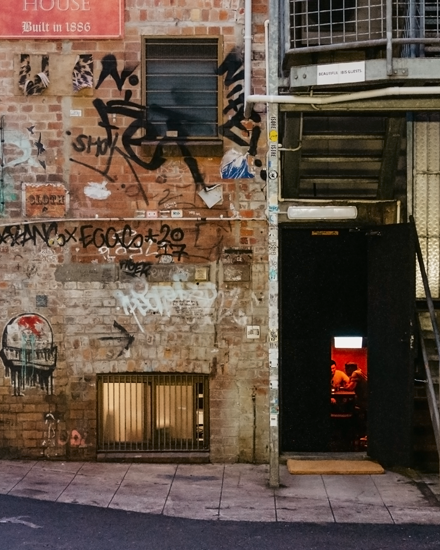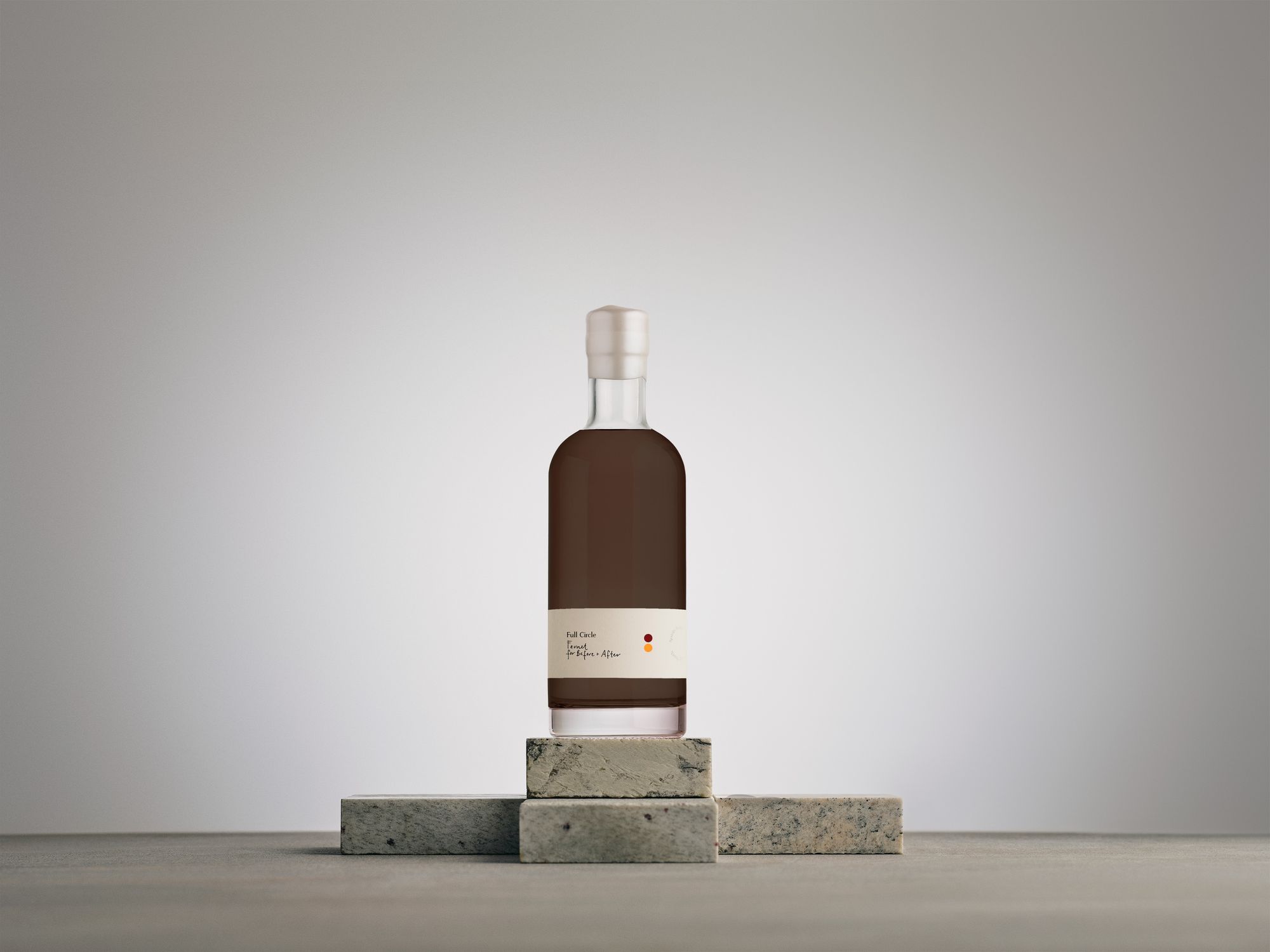One year in, and launching their own custom fernet: Before + After
“People don’t really know what amaro is — you can’t just leave them to what they’re drinking and expect them to come back.”

Half the job of a great bar operator is just getting the bar’s name out there. You can have a unique offering, first class service, the world’s greatest bartender — but it’s all for naught if people don’t know about you.
That challenge is made even more difficult if, like bartender and owner George Curtis [pictured above], you choose to open your bar someplace hard to find.
Before + After is George’s Brisbane bar, and he’s celebrating its first birthday this month — happy birthday! — and to do so, George has teamed up with Full Circle Spirits in South Australia to produce a full-on Australian fernet.
Made with a fruit base of kumquats along with saffron, gentian, wormwood, and a host of other botanicals, the release makes sense for Before + After — it is Brisbane’s only speciality amaro bar. And the release of this fernet is a way to celebrate the birthday milestone, sure, but it offers more opportunity than that.
“It’s just another way to get the bar’s name out there,” says George. As you’ll read in the interview below, he’s happy with how things are going at the bar after the first year — he’s just hired the bar’s first manager, meaning he can take a day or two off, and the bar has picked up some awards recognition as well. And recently, George has turned his mind toward collaborations and takeovers, having recently popped up for a night at One Or Two in Melbourne.
“Networking nowadays is so important, you’re seeing all these takeovers everywhere, collabs, everything,” says George. “So I think rather than just say, hey, we’re turning one, come and have a party, it’s an opportunity to put the name out there again and just create another avenue to get people in the door.
“It’s huge for us being a small bar. It’s not as easy as it is for other bars to get the name out there. So I think it’s a cumulative effect of having nominations for awards, doing collaborations, doing takeovers and just really try to push the brand — that’s really important to me.”
I love this idea. I think if we want a rich and rewarding bar scene, one that provides creative (and remunerative) careers for bartenders, and one that also delights its guests, then we want to see more bars like Before + After — bartender-owned small bars bursting with creativity and a point of view, seeking out new areas in which to exercise that creativity and explore and expand their brands.
That sounds like a great place to drink at, right?
You can read more about George’s first year, why he thinks these collaborations are important, and what makes a fernet a fernet, in the interview below.
Sam Bygrave: It’s one year of trade for Before + After. How do you feel the bar is going?
George Curtis: I think it’s pretty much where I wanted it to be. I think with the concept and the kind of secret hideaway space, it was always going to be a little bit of slower progress in the first year. But I think what we’ve achieved so far has been really great and to rank where we did in the Boothby awards [number 11 on the list of Queensland’s best bars ] and then to get a nomination at the Australian Bartender awards for best new bar is incredible. So yes, really stoked with it. I think just to get through the first year — some businesses can struggle or don’t quite make it. I’m really proud of it.
The success so far is still being there, right?
Yes, exactly.
For people who haven’t been there, give us the elevator pitch for Before + After. What’s it all about?
The main concept is amaro, which is obviously quite unique to Brisbane but also for Australia. So we have about 75 amaros on the back bar. We use it in cocktails. It’s definitely the showpiece of the whole venue. Our whole service is centred on selling it and educating people, using it in all aspects of the bar. We’re hidden away down a laneway, there’s no signage at the moment, we’re a basement bar. So the whole thing is a little bit unique. But yes, if you come to Before + After, then you’re going to get amaro in some way or shape.
It’s only a small bar, so 32 seats, very personal kind of service. We’re very customer service orientated. And that’s exactly why it’s been designed that way, we like to have dialogue with customers and have that educational feel, but also, I think, produce cracking drinks and have some great bottles on the back bar.
Why amaro — what was the reason for opening a bar around that kind of product?
It’s a personal kind of interest of mine or love of mine. It started maybe five or six years ago, just through drinking it. There’s no real romantic story unfortunately, but I just...
No memory of sipping amaro, walking down the back streets of some Italian village?
I wish I could say that. It was just a case of discovering it, drinking it, collecting it as a personal hobby. I started to import a lot from these random websites in Italy, that had a lot of vintage stuff. And my whole career I’ve been working towards opening a bar and it kind of clicked into place in the last few years to kind of determine what the concept would be, a) because I love it and feel it’s much easier to open a bar where you can kind of flaunt your own personal obsession but also b) there’s such a gap in the market in Brisbane and Australia. There’s nothing really that’s a real specialist amaro bar, maybe a couple of bars in Sydney. It’s really exciting to bring something new to the city. I think we have a plethora of gin bars, whiskey bars, cocktail bars, classic bars, but to do a laneway basement amaro bar was pretty exciting — if not a bit of a risk.

Was there anything you had to do to get Brisbane people excited about that idea? I can’t imagine people were marching in the streets demanding an amaro bar...
I think there’s a bit of two things really. When I was working at Agnes I implemented a small but still interesting amaro program there. So the Agnes’ food is big, bold, rich flavours and amaro made total sense to have after dinner. And that was almost like a test run for me to see how people would react to it, and it went very well. To be honest, I still get a few people coming into Before + After now saying that they were introduced to it at Agnes. So it worked. That was my little playground at the time.
But after that, I think it was just having the confidence that it would work and making sure that everything we did was perfect. So all the drinks we put out, we make sure that they’re as good as they can possibly be. They’re well balanced and tasty. But then, crucially, is customer service — once we get people in the building, it’s then crucial what we give them the experience that kind of motivates them to come back, and they want more of it. So that’s why it’s such a customer-focused thing, because obviously, people don’t really know what amaro is, you can’t just leave them to what they’re drinking and expect them to come back. So yes, a lot of dialogue and just having total faith as well that it all works. There’s no point if you’re going to be worried that you might not make it. Trust in the process and [have] confidence in what you’re doing.
What has been the biggest challenge that you faced so far?
I think just getting people in the door, to be honest, with no signage. It’s not an accident that we don’t have signage. It’s just part of playing on the hidden concept. But yes, just getting people in the door because once we do, they come back. So we have a real strong foundation of regulars now, a lot of semi-regulars as well, people coming back. So it is just getting people in the door. And to be honest, I have given in a bit — I’ve got a couple of signs on the way, which I’m a little bit dirty about, but if we can give the people what they want, right?
The location — even with a couple of signs on the street — it’s still still out of the way. I guess it works with the concept, too, right? Because you’re not on the main street, so you don’t get everyone popping in — it’s a bit of a destination. You’ve got to have a certain buy-in, right?
That’s absolutely true. I think we can find a middle ground somewhere and maybe the signs will provide that just to get a few extra bodies in the door, but it’s also more rewarding that way; when people do find it — not only for us because we’re stoked to see new people come in and people come back — but also for them, there’s always that feeling that they found this bar, so that they feel really attached to it immediately. They bring their friends and say, “Hey, come down this laneway, trust me, et cetera. So...
There’s a lot of trust there...
When you get the first dates, and one turns up early and the other one is lagging behind, they’re like, ‘where the hell are you taking me on this first date?’ But yes, hopefully, the signs will just help a little bit.
We obviously don’t want the place to be overrun with people not knowing what’s going on and then we’ve got our work cut out. We want it to still be personal and special to people.

Now you’re celebrating the 1-year anniversary we your own kind of collaboration fernet, right?
Yes, that’s right.
What’s the idea behind that? Why did you want to do this as a way to celebrate this milestone?
So the relationship with Full Circle Spirits goes back to October last year, they came up and did the Brisbane Food & Wine weekend, and they did a takeover at Before + After. And we really hit it off to be honest, just on a personal level, but also the two businesses have quite a similar ethos.
I really respect what Full Circle do, they’re great people, they produce some amazing spirits. It was first mentioned back then that they wanted to make something for us. They do a cracking amaro, we had a quick chat about it and then it kind of went down the line. And early this year, we had a proper talk and kind of brainstormed an idea and fernet was the obvious choice, a) because it’s cool and b) because there’s not really an Australian fernet. I know Beechworth has one that they liken to fernet, but to officially market something as a fernet would be a first in Australia, I think.
What’s the definition of a fernet for you?
Well, it’s the Wild West of spirits. But I think ultimately, it just has to be really, really bitter, really aggressive, really herbal. Generally, you’re going to see some saffron, various other botanicals like aloe and myrrh, but there’s not really a written definition of it. It’s a bit wishy-washy.
And so what is the defining kind of character of this fernet that you’re doing?
A couple of things — we’re using kumquats as a base fruit. So it’s got that kind of juiciness upfront. We brainstormed mangoes originally, but Rose the head distiller said it was an absolute ball ache to distil mangoes, it all gets caught up in the production process. So mangoes were binned and then we settled on kumquats, they’re very accessible and easy to use and have great flavour as well. So it’s juicy, and it’s rested in muscat barrels as well for a short time [which] just rounds it out with a little bit of woody spiciness. And of course, classic botanicals like gentian, wormwood orris root, liquorice root to give it that aggressive bitterness. But we still feel because of the kumquats and the slight ageing that it’s really well rounded. And the idea was not to produce a fernet that bartenders can just neck. We’ve already got Fernet Branca for that. We want something that’s highball and cocktail approachable, so we’ve gone slightly towards a fruitier, lighter style, but still with the characteristics of a woody, spicy fernet as well.
Why is it important to celebrate with this kind of collaboration?
I think it’s just another way to get the bar’s name out there. Networking nowadays is so important, you’re seeing all these takeovers everywhere, collabs, everything. So I think rather than just say, hey, we’re turning one, come and have a party, it’s an opportunity to put the name out there again and just create another avenue to get people in the door. It’s huge for us being a small bar. It’s not as easy as it is for other bars to get the name out there. So I think it’s a cumulative effect of having nominations for awards, doing collaborations, doing takeovers and just really try to push the brand — that’s really important to me.
Will be able to buy this bottling, or is it only available at the bar? Are they going to be able to buy bottle for themselves?
Yes, it will be available through the Full Circle website once we launch it on the 27th, but they’ll also be able to buy it in the venue on the day. And that’ll be through the website as well.
That’s great.
It is limited. So it’s 300 bottles, I believe, we are producing first up. And then if it’s successful, as we fully expect it to be, we’ll produce more. We’ve also penciled in a competition as well in Adelaide and Brisbane to get bartenders involved drinking and selling it and using it.
You can celebrate the first birthday of Before + After on the 27th of August — follow them on Instagram at @beforeandafterbar and find them in real life at down the laneway, 181 George Street, Brisbane.

